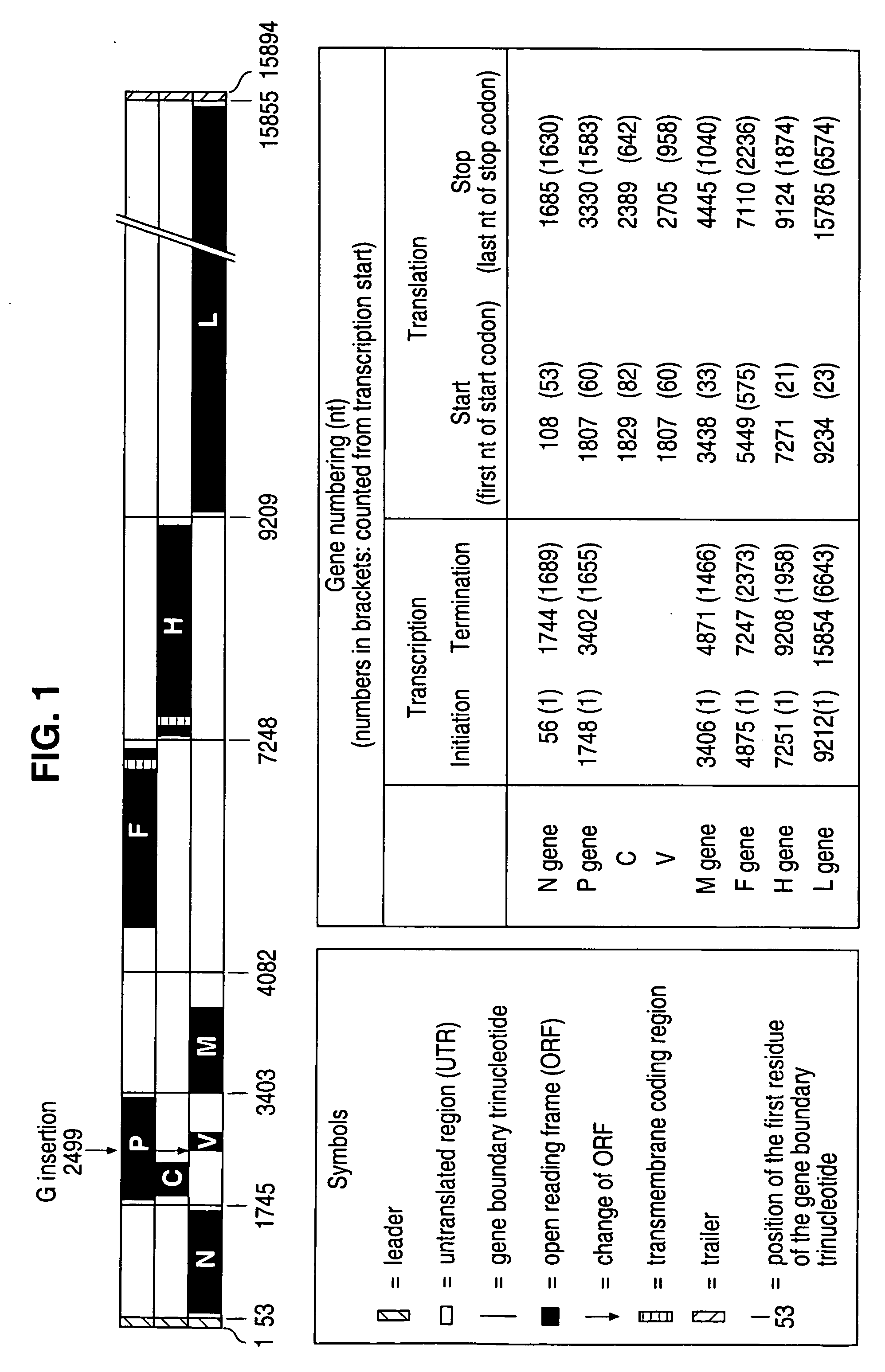cDNA corresponding to the antigenome of nonsegmented negative strand RNA viruses and process for the production of such viruses
a technology of cdna and antigenome, which is applied in the field of methodology for the generation of nonsegmented can solve the problems of high death, increased production costs, and increased production costs of cdna clones of negative strand rna viruses
- Summary
- Abstract
- Description
- Claims
- Application Information
AI Technical Summary
Problems solved by technology
Method used
Image
Examples
example 2
Generation of Cell Line 293-3-46
[0113] Before the transfection, all plasmids were linearized by digestion with SfiI and sterilised by ethanol precipitation. Cells were seeded into one 35 mm well for transfection during 13 h as described below. The transfection mix contained 5 μg of pSC6-N, 4 μg of pSC6-P, and 1 μg of pSC6-T7-NEO. Then, cells were washed once with 2 ml of phosphate buffered saline (PBS; 137 mM NaCl, 2.7 mM KCl, 8 mM Na2HPO4, 1.5 mM KH2PO4), and DMEM containing 10% FCS was added. After 2 days in culture, the cells of the 35 mm well were splitted to two 75 cm2 dishes, and selection under 1.2 mg / ml G418 was started changing the medium every second day. After ˜2 weeks, the first clones of a total of ˜100 clones were transferred to 5 mm wells. When a clone had expanded to a 21 mm- or 35 mm well, cells were seeded for screening. The expression of the MV N and P proteins was analysed by Western blotting (see also below) using ˜⅓ to 1 / 10 of the total lysate of a confluent 2...
example 3
Plasmid Constructions
[0114] All cloning procedures were basically as described in Sambrook et al. (1989). PCR amplifications were carried out using the proofreading Pfu DNA polymerase (Stratagene) and primers with a 3′ terminal phosphorothioate bond instead of a phosphodiester bond (Skerra, 1992). DNA sequences of the synthetic oligonucleotides are given in lower case for non-MV nucleotides and in upper case for the MV nucleotides; sequences of relevant restriction endonuclease recognition sites are underlined. The construction of the plasmid p107MV(−):CAT can be found in Sidhu et al., 1995. Plasmid p107MV(+):CAT is the analogue of the plasmid p107MV(−):CAT. The additional intercistronic region of p(+)NP:CAT that is similar to the NP intergenic boundary was constructed by inserting (5′-ctaGCCTACCCTCCATCATTGTTATAAAAAACTTAGGAACCAGGTC CACACAGCCGCCAGCCCATCAACgcgtatcgcgata-3′, MV(+) 1717-1782) and the internally complementary oligonucleotide into the SpeI site of the P gene. The PCR-amp...
example 4
Transfection of Plasmids and Harvest of Reporter Gene Products
[0118] Cells were seeded into a 35 mm well to reach ˜50-70% confluence when being transfected. 3-8 h before transfection, the medium was replaced with 3 ml of DMEM containing 10% FCS. G418 was omitted henceforth because of its toxic effect during transfection. All plasmids were prepared according to the QIAGEN plasmid preparation kit. The protocol for the Ca2+ phosphate coprecipitation of the DNA was adapted from Rozenblatt et al. (1979). The plasmids (2-10 μg per 35 mm well) were diluted with 300 μl of 1× transfection buffer (137 mM NaCl, 4.96 mM KCl, 0.7 mM Na2HPO4, 5.5 mM dextrose, 21 mM HEPES pH 7.03). 1 M CaCl2 solution was added to a final Ca2+-concentration of 125 mM, and the mix was incubated at 20° C. for 30-120 min. The coprecipitates were added dropwise to the culture and the transfection was carried out at 37° C. and 5% CO2 for ˜15 h. Then, the transfection medium was replaced with 3 ml of DMEM containing 10%...
PUM
| Property | Measurement | Unit |
|---|---|---|
| Immunogenicity | aaaaa | aaaaa |
Abstract
Description
Claims
Application Information
 Login to View More
Login to View More - R&D
- Intellectual Property
- Life Sciences
- Materials
- Tech Scout
- Unparalleled Data Quality
- Higher Quality Content
- 60% Fewer Hallucinations
Browse by: Latest US Patents, China's latest patents, Technical Efficacy Thesaurus, Application Domain, Technology Topic, Popular Technical Reports.
© 2025 PatSnap. All rights reserved.Legal|Privacy policy|Modern Slavery Act Transparency Statement|Sitemap|About US| Contact US: help@patsnap.com



